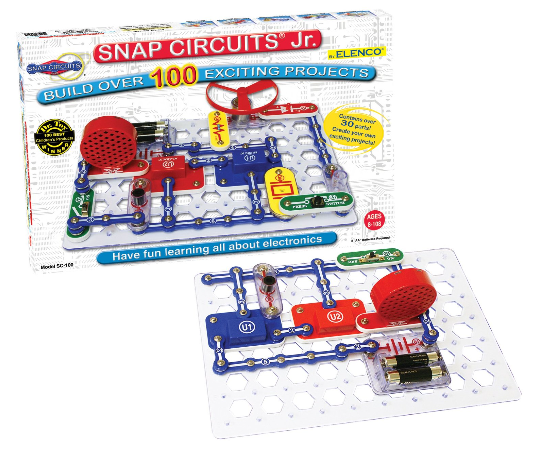 |
| Snap Circuits Jr. |
The kids who like this activity, REALLY like this activity. I have used it a lot to work on spatial skills. Build an electrical or electronic project from the book and IF everything is EXACTLY as it should be, something will happen - a fan may twirl and take off, an alarm could sound, or music might begin to play. Even something as small as a tiny light bulb going on is quite satisfying when you know you made it happen!
The pieces have snaps on them that secure them to the plastic nubs on the base so that they stay in place, hence the name Snap Circuit. There are 101 projects and some take as few as 8 pieces, while others may take up to 25. The pieces in the diagram are numbered according to the level. For instance, a model may have three layers that overlap. All pieces that are on the first layer are labeled 1, second layer are labeled 2, third layer labeled three, etc.
Some of the projects are flying saucer, voice control, motor space sounds, blinking double flashlight, space battle sounds, light-controlled lamp, light/water space war. I like the simple water alarm because every time you dip the jumper wires into the cup of water you get a different sound. And every time someone dips the jumper wires into the water I cringe. Water and electricity/electronics should never go together in my mind, so I quit using that project. I would not want anyone experimenting with wires and water at home.
Requires 2 AA batteries. The plastic grid is marked with coordinates A-G and 1-10. It is an inexpensive activity and the quality of sound is not real clear through the speaker, but fun none the less. Snap Circuit has a lot of different sets available.
Try this:
- Use a project that did not work as a natural opportunity for problem solving. Compare each piece to the book and see what went wrong and fix it until it works.
- Call out each piece and its coordinates so that an individual not looking at the book can put it together.
- Use a Popsicle stick to pry pieces out of the plastic holder if you can't get them out easily. I just keep one in the box.
- Hand the builder a piece at a time, pointing to where it goes on the grid for beginners. Reduce your assistance as the individual progresses.
- Work on visual discrimination, spatial relations, visual closure, figure ground, finger strength and dexterity, manual dexterity, in-hand manipulation, executive functioning skills, process skills, play and leisure exploration and participation, eye-hand coordination, using two hands together in a coordinated manner, problem solving
In
the box: A plastic grid, lots of plastic pieces including speaker, fan,
whistle chip, slide switch, resistor, space war integrated circuit,
music integrated circuit, battery holder, lamp socket, etc., instruction
book with 101 electronic experiments




No comments:
Post a Comment
Thank you for taking the time to comment.